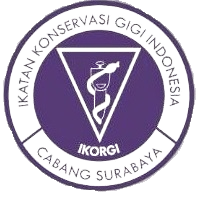Effect of 405 nm Diode Laser with Varying Irradiation Time on BHK-21 Fibroblast Viability
Downloads
Background: Laser is a device that emits light through a process of optical amplification based on the stimulated emission of electromagnetic radiation; it can be used for surgery, detoxification, bio stimulation and antibacterial. However, lasers have Biphasic Dose Response (BDR), which is bio stimulation and bio inhibition. To determine if 405 nm laser diode is biocompatible, viability test is necessary before these lasers can be labeled as viable to use in dental therapy. Aim: To prove the variation of radiation time of the 405 nm laser diode radiation can cause bio stimulation and bio inhibition response that affects the viability of BHK-21 fibroblast cells. Method: Viability test was carried out using BHK-21 fibroblast cells which were inserted into 96-well microplate, then radiated with 405 nm laser diode with varying irradiation time of 30s, 60s, 120s, 240s and 480s. After radiation, the cells are then incubated for 24h. Cytotoxicity was observed using MTT assay and ELISA reader. Data was analyzed using the Kolmogorov-Smirnov test, Levene Test, Welch ANOVA, and Tukey HSD. Results: BHK-21 fibroblast cells radiated with 405 nm laser diode with radiation time of 30s, 60s, 120s, and 240s have the same viability as the control cell, while at 480 seconds the viability exceeds that of the control cell. Conclusion: 405 nm laser diode with radiation times of 30s, 60s, 120s, and 240s do not affect the viability of BHK-21 fibroblast cells. Meanwhile, 480s irradiation time of 405 nm laser diode causes bio stimulation response that increases the viability of BHK-21 fibroblast cells.
Saquib S, Jadhav V, Priyanka N, Perla N. Low-level laser therapy in dentistry : A review. 2015;(2014):8–10.
Gagnon D, Gibson TWG, Singh A, Linden AR, Kazienko JE, Lamarre J. An in vitro method to test the safety and efficacy of low-level laser therapy ( LLLT ) in the healing of a canine skin model. BMC Vet Res [Internet]. BMC Veterinary Research; 2016;1–10. Available from: http://dx.doi.org/10.1186/s12917-016-0689-5
Basso FG, Pansani TN, Turrioni APS, Bagnato VS, Hebling J, Costa CADS. In Vitro Wound Healing Improvement by Low-Level Laser Therapy Application in Cultured Gingival Fibroblasts. 2012;2012:1–7.
Gkogkos AS, Karoussis IK, Prevezanos ID, Marcopoulou KE, Kyriakidou K, Vrotsos IA. Effect of Nd : YAG Low Level Laser Therapy on Human Gingival Fibroblasts. 2015;2015.
Manuscript A, Nuts T. NIH Public Access. 2013;40(2):516–33.
Huang Y, Sharma SK, Carroll J, Hamblin MR. Biphasic dose response in low level light therapy – an update. 2011;602–18.
Freshney RI. Culture of Animal Cells: A Manual of Basic Technique and Specialized Applications. 7th Ed. 7th ed. New Jersey: John Wiley and Sons Inc; 2016. 365 p.
Emilda Y, Budipramana E, Kuntari S. Uji toksisitas ekstrak bawang putih ( Allium Sativum ) terhadap kultur sel fibroblast ( Garlic ( Allium Sativum ) extract toxicity test on fibroblast cell culture ). 2014;47(4):215–9.
Calderhead RG, Vasily DB. L o w Le v e l L i g h t Th e r a p y with Light-Emitting D i o d e s f o r t h e A g i n g Fa c e. Clin Plast Surg [Internet]. Elsevier Inc; 2016;43(3):541–50. Available from: http://dx.doi.org/10.1016/j.cps.2016.03.011

CDJ by Unair is licensed under a Creative Commons Attribution 4.0 International License.
1. The journal allows the author to hold the copyright of the article without restrictions.
2. The journal allows the author(s) to retain publishing rights without restrictions










